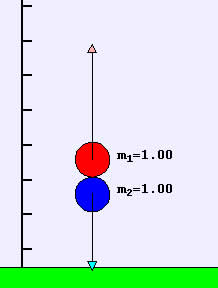

We study ODE event models and show how they can be used to detect hard disk collisions in models such as the ideal gas and Newton's cradle. We also introduce discrete maps and Poincare sections.
The Falling Balls Collision Model simulates two balls constrained to move in one dimension above a floor in a constant gravitational field with g=1. Users can modify each ball's position and velocity and the ratio of the two masses before starting the simulation. Users can also drag the balls.
In the Two Ball Bounce Model, two balls are acted on by a constant force of gravity and by strong but brief collision forces. When the bottom (blue) ball collides with the floor, its velocity is reversed in direction so that it is moving upward. This ball-floor collision conserves kinetic energy KE but not y-momentum p=mv. Both energy and momentum are conserved when the balls collide with each other.
KE before = KE after
pbefore = pafter
where
KE = (1/2) m1 v12 + (1/2) m2 v22
p = m1 v1 + m2 v2
We can solve these equations for the velocities v1 and v2 after the collision using the known velocities before the collision. The solution is straightforward in the center of mass reference frame because the total momentum p is zero. In this reference frame the particle momenta are equal but opposite so both momentum and energy are conserved if v1 and v2 change sign. This simple algorithm is implemented in the ODE event action that handles the collision.
double vcm=(m1*v1+m2*v2)/(m1+m2); // transform into cm frame v1 -= vcm; v2 -= vcm; // reverse velocity to conserve energy and momentum v1 = -v1; v2 = -v2; // transform into lab frame v1 += vcm; v2 += vcm;
Exercise: Prove that the total momentum is zero in the center of mass frame starting with the definition of the center of mass.
Exercise: A well known physics demonstration places a small ball on a larger ball and then dropping them together. (A tennis ball placed atop a basketball works well.) Because the larger ball's velocity changes sign when it collides with the floor, the relative velocity between the two balls is larger resulting in a very fast moving projectile. Demonstrate this effect.
The following models use ODE events to detect collisions between hard objects (disks or spheres).
The following models explore iterative maps:
The following dynamical systems are investigated using Poincare maps:
Additional models may be be posted for self-study.
The Two Ball Bounce Model was created by Wolfgang Christian using the Easy Java Simulations (EJS) version 4.1 authoring and modeling tool. You can examine and modify a compiled EJS model if you run the model (double click on the model's jar file), right-click within a plot, and select "Open Ejs Model" from the pop-up menu. You must, of course, have EJS installed on your computer.
Information about Ejs is available at: <http://www.um.es/fem/Ejs/> and in the OSP comPADRE collection <http://www.compadre.org/OSP/>.